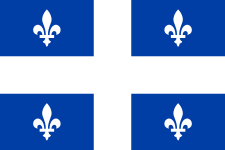A montreali és quebeci levegőminőségi adatok egy ideje rendelkezésre állnak, de a közelmúltban néhány kérdésünk volt a Kanada ezen részén használt AQI skálával kapcsolatban. Egyikük Marie A.-tól származik, aki megkérdezte:
Érdeklődni szeretnék, hogy az Ön webhelyén található levegőminőség-index miért különbözik a Montreal webhelyén található AQI-től? Újraszámol valamit, hogy megfeleljen az US EPA AQI szabványainak? Ha igen, hogyan? Milyen adatokkal?
Például: július 14. 14:00, a webhelyén található indexek többsége 53 és 65 között van (egy index 37), és ez valós idejű AQI. Montreal city honlapján július 14-én 14:00-án a legtöbb index 16 és 37 között mozog, és ez is valós idejű AQI.
Szóval, elmagyaráznád nekem a különbséget, és hogy milyen szabványrészleteket használsz?
Ez valóban nagyon jó kérdés. és ebben a cikkben elmagyarázzuk a használatban lévő különböző skálákat, a skálák egymáshoz viszonyítását, és az átalakítás mikéntjét.
oOo
Amint azt egyik korábbi cikkünkben kifejtettük, a World Air Quality Index projekttel kapcsolatban közzétett összes AQI adat jelenleg [1] az US EPA szabványt használja. Sem Montreal, sem Quebec nem várja el ezt a szabályt, tehát ez megerősíti, hogy a city/montreal oldalon megjelenő értékek a US EPA szabványt használják.
Ez az oka a World Air Quality Index projekt és a montreali város honlapja ( montreal.qc.ca ) közötti eltérésnek: A montreali városi EPA (Környezetvédelmi Ügynökség) saját megfelelő AQI skáláját használja, amely egyértelműen le van írva a ugyanaz a weboldal. Annak érdekében, hogy kissé "bonyolultabb" legyen, Quebec valójában egy másik AQI skálát használ ( ezen a linken van megadva ), Montrealhoz (tabarnac!) képest. És természetesen Kanada egy másik skálát is használ, az AQHI-t a levegőminőség egészségügyi indexéhez – de erről már írtunk egy másik cikkben .
A montreali és quebeci AQI töréspontok összefoglalása a következő táblázatban található:
| Pollutant | Quebec | Montreal | ||
|---|---|---|---|---|
| Averaging Period | Reference Value | Averaging Period | Reference Value | |
| Fine Particles (PM2.5) | 3 hours | 35µg/m3 | 3 hours | 35µg/m3 |
| Ozone (O3) | 1 hour | 82 ppb | 1 hour | 160 µg/m3 |
| Nitrogen dioxide (NO2) | 1 hour | 213 ppb | 1 hour | 400 µg/m3 |
| Sulfur dioxide (SO2) | 4 minutes mobile | 213 ppb | 10 minutes mobile | 500 µg/m3 |
| Carbon monoxide (CO) | 1 hour | 30 ppm | 1 hour | 35 µg/m3 |
oOo
Az értékek US EPA szabványra való átszámításához milligrammban vagy ppb/ppm- ben (részecskeszám/milliárd/millió) kifejezett nyers koncentrációra van szükség.
Sajnos sem Montreal, sem Quebec megye nem biztosítja ezt a nyers koncentrációt. Ehelyett csak a saját AQI skálájukra konvertált levegőminőségi értékeket adják meg. De ez valójában nem probléma, mivel a koncentrációra való visszakonverziót az alábbi egyszerű lineáris képlettel lehet végrehajtani:
Raw concentration (pollutant) = Reference value (pollutant) * AQI }(pollutant) / 50Például, ha 18-as PM 2,5 AQI értéket tesznek közzé Montreal város honlapján, akkor a nyers koncentráció milligrammban 18*35/50 = 12,6 mg/m3. Ne feledje, hogy az ózon, CO, SO 2 és NO 2 mértékegysége eltérő Quebec és Montreal esetében (ppb a Quebec – amerikai szabvány és mg a montreali EU-szabvány esetében), de ez csak egy további konverzió (részben ebben a cikkben magyarázható). .
Vegye figyelembe, hogy a PM 2.5 AQI 3 órás átlagon alapul, míg a World Air Quality Index projektben az óránkénti PM 2.5 Instant Cast AQI jelentést használják. Mivel az óránkénti adatokat nem lehet levonni a 3 órás átlagból, ez tulajdonképpen azt jelenti, hogy a World Air Quality Index Montreal és Quebec projektjéről közölt PM 2,5 AQI nem éppen "Instant Cast" jelentés.
oOo
Tehát végül itt van a 3 AQI skála (US EPA, Quebec és Montreal) vizuális összehasonlítása a PM 2,5- re és az ózonra vonatkozóan (megjegyzendő, hogy az ózon esetében a ppm mértékegységet használjuk – tehát a mg-ról ppm-re történő átalakítás Montreal esetében megtörténik) .
Érdekes észrevétel, hogy Quebec és Montreal is a 25-ös AQI-értéket használja a jó (zöld) és az Elfogadható (sárga) közötti töréspontként, míg az US EPA esetében ez a töréspont 50-re van beállítva. , ha a megfelelő konverziót és töréspontokat szem előtt tartva almától almáig hasonlítjuk össze, a jelentett AQI tartomány nagyon hasonló a US EPA szabvány és a quebeci/montreali szabványok között.
--
Az egyes országokra vagy kontinensekre vonatkozó további információkért tekintse meg ezeket a cikkeket: Thaiföld és Malajzia - India - China - Hongkong/Kanada (levegőminőség-egészségügyi index) - Dél Amerika - Ausztrália - Quebec és Montreal - Szingapúr - Lengyelország - Indonézia .
Az alkalmazott 24 órás átlagolásról vagy az ózonról és a szálló porról (PM 2,5 ) a következő két cikkben olvashat: Ground Ozone Index – PM 2.5 Instant Cast

